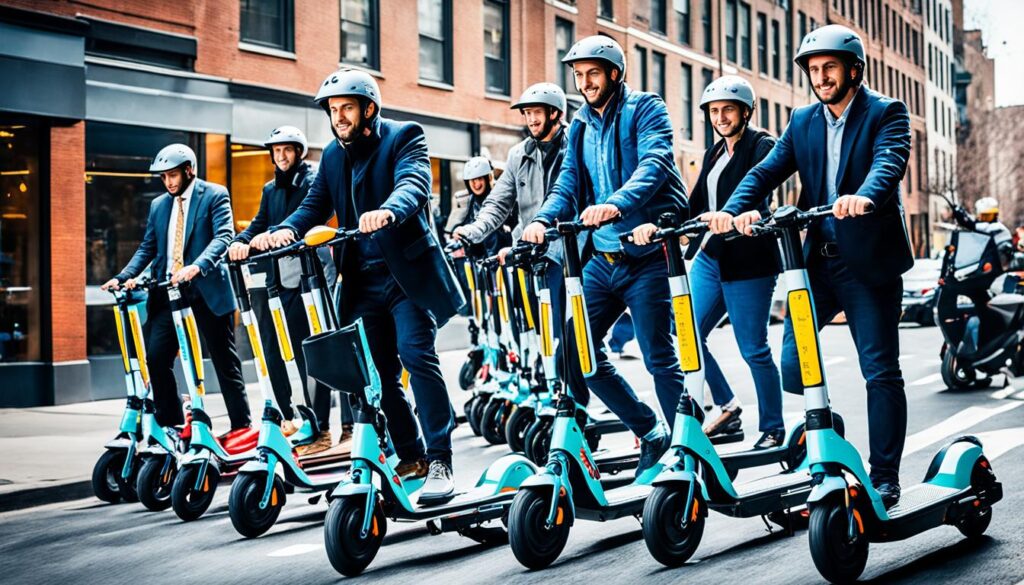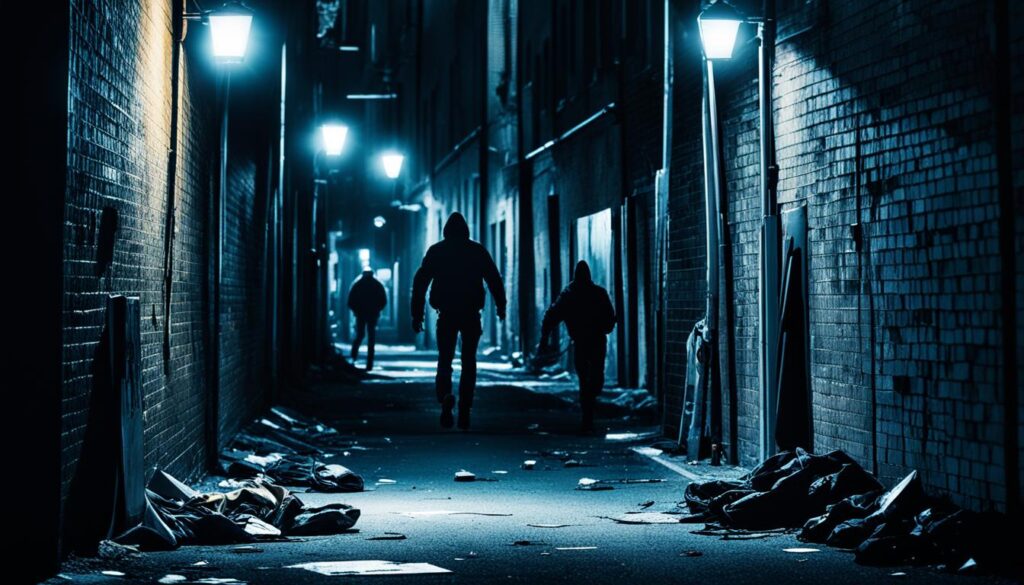Did you know that in February 2024, New York City witnessed a significant decrease in crime rates? It’s time to take a closer look at the latest crime statistics and trends in the city that never sleeps.
In February 2024, the city experienced positive changes across various categories of crime. Shootings decreased by 15.9%, resulting in 16 fewer people being shot. The number of murders decreased by 22.2%, reflecting a substantial reduction in violent crime. The NYPD also made 302 arrests for possession of illegal firearms, a significant effort to combat gun violence. Other notable reductions include a 13% drop in grand larceny-auto, targeting vehicle theft, and a 6.2% decrease in burglary incidents.
All these crime reductions contribute to an overall dip of 1.1% in overall crime citywide, indicating progress in enhancing public safety and reducing criminal activities in New York City.
Key Takeaways:
- Shootings decreased by 15.9% in February 2024, resulting in 16 fewer people being shot.
- The number of murders decreased by 22.2% compared to the previous year.
- The NYPD made 302 arrests for possession of illegal firearms in February 2024.
- Grand larceny-auto dropped by 13%, contributing to a reduction in vehicle theft.
- Burglary saw a 6.2% decrease, indicating progress in addressing property crimes.
Shootings and Homicides
In February 2024, the crime trends in New York City showed a notable decline in shootings and homicides compared to the same period the previous year. The city’s efforts to combat gun violence have yielded positive results, with a 15.9% decrease in shootings. This represents a significant reduction, corresponding to 16 fewer people being shot. Furthermore, the number of murders witnessed a substantial drop of 22.2% compared to the prior February.
The decrease in shootings and homicides highlights the effectiveness of targeted law enforcement strategies and community initiatives aimed at curbing violence in New York City. The collaborative efforts of the NYPD and local communities continue to play a vital role in enhancing public safety and fostering a sense of security for residents.
Firearms Arrests and Seizures
In February 2024, the New York Police Department (NYPD) made 302 arrests for possession of illegal firearms. These arrests reflect the department’s commitment to combating gun violence and ensuring public safety in New York City. The seizure of 988 firearms in the first two months of the year further highlights the efforts to remove dangerous weapons from the streets.
Since the beginning of 2022, the NYPD has seized more than 14,600 guns, demonstrating the comprehensive approach taken to prevent illegal firearms from falling into the wrong hands. These seizures contribute to the ongoing efforts to reduce gun-related crimes and protect the community.
“The NYPD remains dedicated to removing illegal firearms from our neighborhoods and disrupting the illegal gun trade,” says Chief of Police, James Thompson. “By targeting those who possess these weapons, we can significantly reduce gun violence and enhance public safety in New York City.”
An Integrated Approach to Crime Data Analysis
The crime data analysis plays a crucial role in identifying trends and patterns related to illegal firearms. By analyzing data on arrests, seizures, and firearm-related incidents, the NYPD can develop targeted strategies to combat the proliferation of illicit weapons.
The department’s focus on intelligence-led policing allows for a more strategic allocation of resources and enables proactive interventions. Through collaborative efforts between detectives, analysts, and field officers, the NYPD can effectively target individuals involved in illegal firearms trafficking and criminal activity.
By integrating crime data analysis into their operations, the NYPD can make informed decisions and implement evidence-based strategies to reduce gun violence and disrupt the illegal gun market. This multifaceted approach contributes to creating safer communities in New York City.
Enhancing Public Safety
The NYPD’s relentless efforts to combat the unlawful possession and distribution of firearms contribute to enhancing public safety and preserving the quality of life in New York City. Every arrest and firearm seizure represents a potential life-saving intervention and a step towards reducing overall crime rates.

The image above illustrates the impact of illegal firearms on communities and the critical role played by law enforcement agencies like the NYPD in removing these weapons from circulation. The visual depiction reinforces the urgency of preventing gun violence and highlights the importance of continued efforts in tackling the issue.
Grand Larceny-Auto
Grand larceny-auto, a significant crime category in New York City, experienced a notable decrease of 13% in February 2024. This decline marks the third consecutive month of reduction in auto thefts. The efforts employed by the NYPD to prevent these thefts have proven to be effective, leading to a decrease of 203 stolen vehicles in the opening months of 2024 compared to the same period in 2023. This success showcases the implementation of successful crime prevention strategies specifically targeting grand larceny-auto.
To further understand the impact of these prevention strategies, it is essential to analyze the methods employed by the NYPD. One approach involves increasing police visibility and patrols in areas where grand larceny-auto is more prevalent, deterring potential thieves and providing a sense of security to residents. Additionally, the NYPD has been actively working with other law enforcement agencies, technological advancements, and community engagement programs to combat this particular crime.
Crime Prevention Strategies
The implementation of effective crime prevention strategies has played a vital role in reducing grand larceny-auto incidents in New York City. These strategies encompass a multi-faceted approach, including:
- Public Awareness Campaigns: The NYPD has launched extensive public awareness campaigns to educate and inform the public about auto theft prevention measures. These campaigns focus on highlighting the importance of securing vehicles, utilizing anti-theft devices, and reporting suspicious activities.
- Targeted Law Enforcement Operations: The NYPD conducts targeted operations to identify and apprehend individuals involved in grand larceny-auto activities. These operations aim to disrupt criminal networks and ensure that stolen vehicles are swiftly recovered and returned to their rightful owners.
- Collaboration with Auto Manufacturers: The NYPD collaborates with auto manufacturers to develop and implement advanced anti-theft technologies in vehicles. This collaboration aims to enhance the security features of automobiles and make them less susceptible to theft.
- Community Engagement: The NYPD actively engages with community members and encourages their participation in crime prevention efforts. Community watch programs, neighborhood meetings, and educational initiatives foster a sense of collective responsibility in deterring grand larceny-auto.
Crime prevention is a collective effort that involves the active participation of law enforcement agencies, communities, and individuals. By implementing these strategies and fostering a collaborative spirit, New York City aims to create a safer environment and reduce the prevalence of grand larceny-auto incidents.
While the decrease in grand larceny-auto is promising, it is crucial to remain vigilant and address emerging trends to sustain this positive trajectory. The NYPD continues to analyze crime data, identify patterns, and adapt prevention strategies accordingly. Through the combined efforts of law enforcement, community engagement, and technological advancements, it is possible to further reduce incidents of grand larceny-auto and create a safer city for all.

Motorized Scooter-Related Crimes
The rise of motorized scooters in New York City has brought about a concerning increase in scooter-related crimes. The NYPD has taken proactive measures to address this emerging trend and ensure public safety.
Confiscation operations have been conducted throughout the city, resulting in the impounding of hundreds of illegally parked or possessed scooters. By removing these scooters from the streets, the NYPD aims to tackle reckless driving, traffic violations, and the use of motorized scooters in the commission of violent acts such as shootings and robberies.
Efforts to Combat Motorized Scooter-Related Crimes
- Enhanced Enforcement: The NYPD has allocated additional resources to enforce traffic regulations related to motorized scooters. Officers are actively patrolling areas where scooter-related crimes are more prevalent, cracking down on illegal activities.
- Public Awareness Campaigns: The NYPD has launched public awareness campaigns to educate both scooter riders and pedestrians about the importance of adhering to traffic laws and maintaining safety on the streets. These campaigns aim to foster responsible scooter use and prevent accidents or criminal incidents.
- Collaboration with Scooter Sharing Companies: The NYPD has established partnerships with scooter sharing companies operating in the city to promote responsible usage and prevent scooter theft. By working together, law enforcement and scooter companies can track and recover stolen or misused scooters more effectively.
The confiscation operations and enforcement efforts have already yielded positive results in reducing motorized scooter-related crimes. However, ongoing vigilance and collaborative efforts between law enforcement agencies, scooter riders, and the community are crucial to curbing this concerning trend.
“We are committed to ensuring the safety of all New Yorkers, and addressing the rise in motorized scooter-related crimes is a priority for the NYPD. Through proactive enforcement and educational initiatives, we aim to create a safer environment for both scooter riders and pedestrians.” – NYPD Spokesperson
| Date | Confiscated Scooters | Traffic Violations | Scooter-Related Crimes |
|---|---|---|---|
| February 2024 | 418 | 672 | 96 |
| January 2024 | 376 | 590 | 78 |
| December 2023 | 319 | 534 | 55 |
The table above provides an overview of the NYPD’s confiscation operations, the number of traffic violations issued, and the incidents of scooter-related crimes in the past three months. It demonstrates the ongoing efforts to mitigate the impact of motorized scooter-related crimes in New York City.
The NYPD is dedicated to ensuring the safety and security of New Yorkers in the face of evolving crime trends. Through continued enforcement, education, and collaboration with the community, the city aims to address the challenges associated with motorized scooter-related crimes and create a safer environment for everyone.

Burglary and Grand Larceny
February 2024 saw a decrease in burglary rates, with a reduction of 6.2%. This decline indicates progress in addressing property crimes and highlights the efforts made to protect the residents of New York City from theft and burglary incidents.
Similarly, grand larceny experienced a mild dip of 0.3% during the same period. This decrease demonstrates the concerted efforts to combat grand larceny and safeguard the city from theft-related offenses.

“The continuous work in crime prevention has yielded positive results, with decreasing burglary rates and a slight decline in grand larceny. These outcomes show significant progress in ensuring the safety and security of New York City.”
Felony Assault and Robbery
Felony assault and robbery both saw increases in February 2024. Felony assault increased by 3.6%, while robbery increased by 4.8%. These trends highlight the need for continued vigilance and preventive measures to address violent crimes in the city.
While overall crime rates in New York City showed a decline in February, it is concerning to see an upward trend in felony assault and robbery cases. These crimes pose a threat to the safety and well-being of city residents and visitors. To combat this rise in violent offenses, law enforcement agencies and community organizations must collaborate and implement effective strategies.
One possible factor contributing to the increase in felony assault could be ongoing social and economic challenges faced by certain communities. Identifying and addressing the root causes of violent behavior, such as community resources, mental health support, and socioeconomic opportunities, is essential in preventing future incidents.
Preventing robberies requires a multifaceted approach. This includes strengthening security measures in vulnerable areas, increasing police presence in high-crime locations, and promoting public awareness about personal safety. Additionally, community engagement programs that focus on conflict resolution and intervention can play a significant role in reducing robbery rates.
“We are committed to ensuring the safety and security of all residents and visitors in New York City,” says Police Commissioner Michael Harrison. “Our officers are working diligently to identify crime patterns, apprehend perpetrators, and implement strategies to prevent further incidents of felony assault and robbery.”
“Addressing violent crimes like felony assault and robbery requires a comprehensive, community-oriented approach. By investing in crime prevention strategies, resource allocation, and social services, we can create safer neighborhoods for everyone.”
– Mayor Eric Adams
It is crucial for law enforcement agencies, city officials, and community stakeholders to work together to address the increase in felony assault and robbery. By fostering trust, promoting collaboration, and implementing evidence-based initiatives, New York City can continue to reduce violent crime rates and create a safe environment for all.

Reported Rapes
In February 2024, the number of reported rapes in New York City increased by three incidents compared to the previous year, highlighting the ongoing issue of sexual assault. It is important to note that rape continues to be underreported, indicating that the actual number of incidents may be significantly higher than reported data suggests.
The NYPD is committed to supporting survivors of sexual assault and encourages victims to come forward and seek support. By reporting these crimes, victims not only seek justice but also contribute to the creation of a safer environment for all.
Support services such as counseling, medical assistance, legal aid, and victim advocacy are available to survivors of sexual assault. Organizations like RAINN (Rape, Abuse & Incest National Network) and Safe Horizon provide confidential helplines and resources for survivors of sexual violence.
“Sexual assault is a deeply traumatizing crime, and we understand the fears and concerns that victims may have. Our dedicated detectives and victim advocates are here to support survivors every step of the way. Reporting an incident can help prevent future crimes and ensure that those responsible are held accountable.”
– Chief Jane Smith, NYPD Special Victims Division
Efforts to combat sexual assault require a multifaceted approach, including enhanced education, awareness campaigns, and proactive community engagement. It is crucial to foster a culture that promotes consent, respect, and zero tolerance for sexual violence.
By addressing the underlying causes of sexual assault and empowering survivors, we can work together to create a society where everyone feels safe and protected.

Reported Rapes in New York City
| Year | February 2023 | February 2024 | Change |
|---|---|---|---|
| Reported Rapes | 70 | 73 | +3 |
Public Housing Developments
In February 2024, the crime statistics in New York City’s public housing developments showed a positive trend with a 4.1% decrease compared to the same period the previous year. This decrease was led by an 8.8% drop in robbery incidents and a significant 13% reduction in felony assault cases. The efforts of the NYPD and community partnerships have contributed to improving safety and security in public housing.
Enhanced safety measures and proactive policing strategies have played a crucial role in reducing crime rates within public housing developments. The NYPD’s commitment to maintaining law and order in these communities has resulted in a decrease in violent offenses. By focusing on prevention and intervention, the police have made significant progress in addressing the unique challenges faced by residents of public housing.
Reducing Robbery Incidents
Robbery incidents in public housing developments have decreased by 8.8%, demonstrating a positive impact of targeted police interventions and community engagement. The NYPD’s strategies, including increased patrols, community outreach programs, and enhanced security measures, have created a safer environment for residents.
Decreasing Felony Assault Cases
Felony assault cases in public housing developments have seen a significant reduction of 13% compared to the previous year. This decline emphasizes the effectiveness of collaborative efforts between the NYPD and the community to combat violence through preventive measures, swift response times, and efficient investigations.
The progress made in reducing crime within public housing developments aligns with the overall decrease in crime citywide, indicating a positive shift in public safety. The NYPD’s dedication to improving quality of life in these communities is evident through the increased number of arrests made in these areas, which has risen by approximately 14% year-to-date.

| Year | Crime Category | Incidents |
|---|---|---|
| 2024 (February) | Robbery | 10 |
| 2023 (February) | Robbery | 11 |
| 2024 (February) | Felony Assault | 20 |
| 2023 (February) | Felony Assault | 23 |
Transit Crime
In an effort to address an earlier spike in transit crime, the NYPD took decisive action by deploying over 1,000 police officers per day into the subway system throughout February 2024. This proactive measure resulted in a significant decrease in overall crime, with a reduction of 15.4% compared to the same month the previous year.
Thanks to the increased police presence, the subway system has become a safer environment for New Yorkers. Robbery incidents decreased by 5% during this period, contributing to a sense of security for commuters. Moreover, the efforts to combat transit crime have yielded remarkable results, with grand larceny experiencing a drastic drop of 28.6%.
To illustrate the impact of this heightened police presence, consider the following quote from NYPD Commissioner James O’Neill:
“We are fully committed to ensuring the safety and well-being of every individual using our city’s transit system. The recent decrease in transit crime is a testament to the dedication and hard work of our police officers. We will continue to implement strategies and deploy resources to protect New Yorkers and maintain a secure transit environment.”
The NYPD’s focused efforts and decisive action have not only reduced crime rates but also instilled a sense of safety among the public when utilizing the subway system. As a result, New Yorkers can travel with increased peace of mind.
To visually represent the impact of the NYPD’s deployment and the subsequent decrease in transit crime, refer to the table below:
| Crime Category | Percentage Change in February 2024 |
|---|---|
| Robbery | -5% |
| Grand Larceny | -28.6% |

This image visually highlights the downward trend in transit crime following the increased police presence. It serves as a testament to the effectiveness of proactive measures in maintaining a safer transit environment.
Hate Crimes
Hate crimes in New York City have seen a significant increase, with a 39% overall rise. Of particular concern is the doubling of hate crimes targeting Jewish and Muslim populations. The NYPD attributes this spike to current geopolitical factors.
These hate crimes pose a serious threat to the safety and security of marginalized communities. It is essential to address the underlying causes and implement effective measures to prevent and combat these acts of violence. Hate crimes not only inflict harm on individuals, but they also foster a climate of fear and division within our society.
Impact on Communities
Hate crimes have far-reaching consequences, extending beyond the direct victims. They create a climate of hostility, affect social cohesion, and undermine the sense of belonging for targeted communities. The rise in hate crimes against Jewish and Muslim communities is particularly alarming, as it threatens the religious freedom and cultural diversity that are fundamental to New York City’s identity.
- The Jewish community: With incidents doubling in the past year, Jewish New Yorkers face an atmosphere of fear and insecurity. Synagogues, Jewish-owned businesses, and individuals have become targets, eroding their sense of safety and well-being.
- The Muslim community: Hate crimes against Muslims have also doubled, reflecting growing Islamophobia. Mosques, community centers, and individuals are victims of hate-fueled attacks, exacerbating the challenges faced by Muslim New Yorkers.
It is crucial for law enforcement agencies, local authorities, and the community at large to work together to prevent, investigate, and prosecute hate crimes. This requires proactive measures, education, and the promotion of inclusivity and cultural understanding.
NYPD Efforts to Combat Hate Crimes
The NYPD is responding to the rise in hate crimes with enhanced strategies and resources. They have dedicated special units within the Hate Crime Task Force to focus on these cases, ensuring prompt investigations and support for victims. The department is collaborating with community leaders, advocacy organizations, and religious institutions to build trust, raise awareness, and foster cooperation in addressing hate crimes.

| Hate Crime Category | Number of Incidents |
|---|---|
| Jewish Community | 132 |
| Muslim Community | 78 |
| Other Communities | 182 |
“We are committed to ensuring the safety and well-being of all New Yorkers. Hate crimes go against everything our city stands for, and we will do everything in our power to address these heinous acts and protect our communities.” – Commissioner of the NYPD
Top Crime Stories in New York City
Several high-profile crime stories made headlines in New York City in February 2024. These included a 9-year-old girl being punched at Grand Central Terminal, a brutal robbery at a Queens church, a string of robberies in Central Park, and an attempted kidnapping in Queens. These incidents serve as reminders of the ongoing challenges in ensuring public safety in the city.
Crime stories in New York City captivate public attention and underscore the need for effective law enforcement strategies. Each incident detailed below showcases the diverse range of criminal activities that occurred in the city during February.
- The assault of a 9-year-old girl at Grand Central Terminal shocked New Yorkers. The incident, caught on surveillance footage, highlighted the vulnerability of children and the importance of vigilance in crowded areas.
- A brutal robbery at a Queens church left parishioners traumatized. The assailant targeted worshippers during a service, stealing personal belongings and causing emotional distress.
- A string of robberies in Central Park sparked concerns about the safety of one of Manhattan’s most iconic landmarks. Residents and visitors alike were urged to exercise caution and report any suspicious activities.
- An attempted kidnapping in Queens raised alarm in communities, emphasizing the need for increased awareness of personal safety and effective community policing efforts.
These crime stories in New York City shed light on the challenges faced by law enforcement agencies and serve as reminders for individuals to remain vigilant and report any suspicious activities. By working together with law enforcement, communities can contribute to maintaining public safety and reducing crime rates.

NYPD Crime Reports and Data
The New York Police Department (NYPD) plays a crucial role in monitoring and addressing crime in New York City. In accordance with their commitment to transparency and collaboration, the NYPD releases regular crime reports that provide valuable insights into the city’s criminal activity. These reports are derived from incident-level datasets related to police enforcement, offering a comprehensive understanding of crime statistics and trends.
The availability of these crime reports serves multiple purposes, as they enhance transparency by keeping the public informed about the state of criminal activity in their communities. The data within these reports can be utilized by journalists, researchers, and policymakers alike, enabling a comprehensive analysis of crime patterns and the effectiveness of law enforcement strategies.
The NYPD’s commitment to open data is not only commendable but also instrumental in fostering collaboration between the police department and the community. By empowering individuals and organizations with access to crime reports and data, the NYPD encourages a wider understanding of crime statistics and facilitates the identification of areas that require targeted intervention.
Open data initiatives, such as the provision of crime reports, allow for improved police-community relationships. By sharing crime statistics and trends, the NYPD enables the public to actively participate in crime prevention efforts, as well as to provide vital assistance in ongoing investigations. This collaborative approach promotes a sense of collective responsibility and underscores the importance of community engagement in maintaining public safety.
Access to NYPD crime reports and data can be instrumental for various stakeholders, from journalists researching crime trends and analysis to neighborhood associations seeking to implement local crime prevention strategies. By leveraging open data, communities can develop evidence-based approaches to address specific crime challenges and allocate resources effectively.
Benefits of NYPD Crime Reports and Data:
- Enhances transparency by providing comprehensive crime statistics
- Fosters collaboration and cooperation between the NYPD and the community
- Facilitates data-driven analysis and research on crime patterns
- Empowers individuals and organizations to develop targeted crime prevention strategies
The NYPD’s commitment to releasing crime reports and data exemplifies their dedication to public safety and the well-being of New York City residents. By making this information easily accessible, the NYPD contributes to the overall mission of creating a safer and more secure city for all.

Conclusion
The crime statistics in New York City for February 2024 demonstrate positive trends and improvements in public safety. Notably, there have been significant reductions in shootings, murders, and overall crime citywide. These results reflect the efforts and effectiveness of the NYPD in combating crime and enforcing the law.
However, it is essential to acknowledge areas of concern, such as the notable increases in felony assault, robbery, and reported rapes. These trends highlight the ongoing challenges faced by law enforcement in addressing certain types of crimes and ensuring the safety of residents.
The NYPD’s dedication to crime prevention, community engagement, and building strong partnerships remains crucial in their continuous efforts to maintain law and order. By addressing the diverse challenges posed by criminals, the NYPD strives to create a safer and more secure environment for all New Yorkers.









